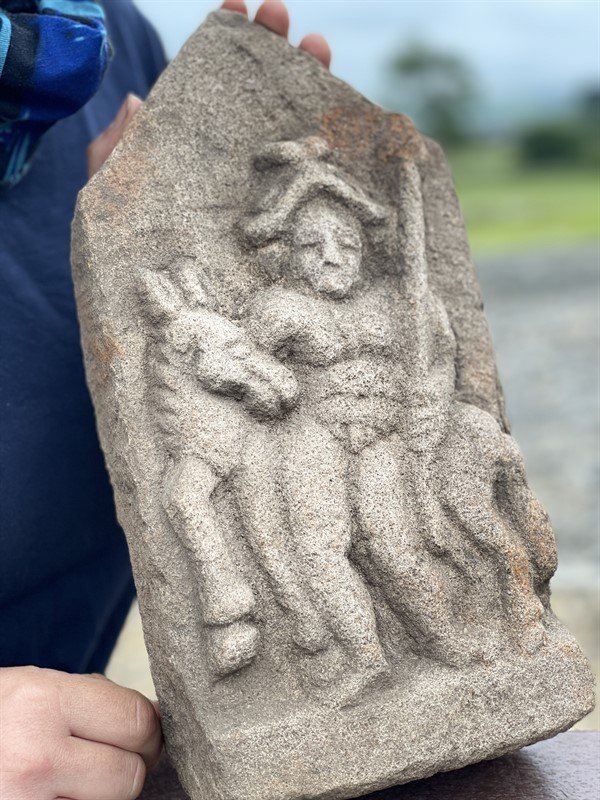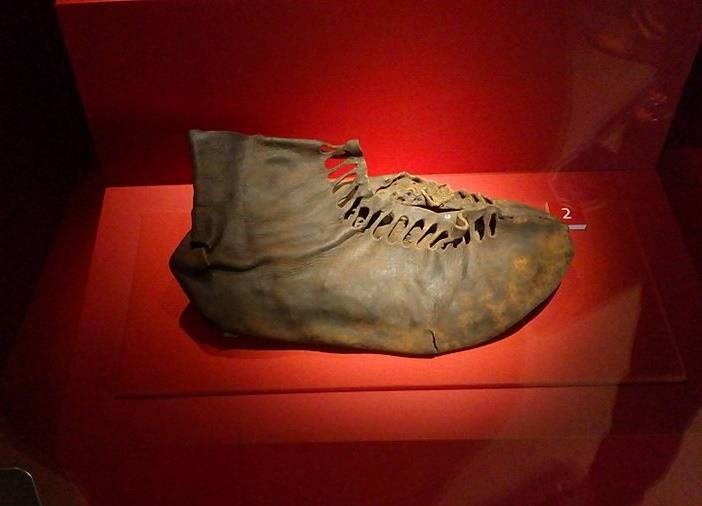
A Roman sandstone altar depicting a naked horseman was discovered at the archaeological site of Vindolanda in northern England. Vindolanda, a fort just below Hadrian’s Wall, was periodically inhabited by the Romans between 85 and 370 CE. He is best known for the ink tablets found there.
Written on thin pieces of wood, they offer a series of first-hand stories from the Romans who once inhabited the fort.
The archaeological site has provided rich material. It includes structures such as military barracks and residences and artifacts such as Roman sandals, combs, textiles, swords, arrowheads, pottery, bronze figurines, and even leather boxing gloves.
Volunteers Richie Milor and David Goldwater discovered the carvings while excavating the floor of a 4th-century cavalry barracks. The altarpiece depicts a naked, muscular man wearing a helmet and a spear. It looks like he is depicted standing in front of a horse or donkey.
In a video showing the find, Archaeologist Martha Alberti explained that sandstone altars like this one often have inscriptions underneath to help determine who they are portraying. Alberti said that the altarpiece should have been placed high in a niche, as the flat back of the altar indicates that it was never intended to be viewed from behind and that it should have been installed right against the wall.
Without an inscription, a rider can only be identified by the attributes associated with him. Given the two rounded portions at the top that could represent wings, Alberti believes the carvings could represent either Mars or Mercury, both of which are well-known Roman gods. Mars was usually depicted with a chiseled physique and an iconic spear, and was usually associated with war; Mercury, the god of travel, is often depicted with donkeys and horses, as well as the typical winged helmet.
The carving is more likely to represent a hybrid god, Alberti said, adding that the cavalrymen living in Windoland could create a god that combined the characteristics of Mars and Mercury, and they could make this unique piece as a tribute. to this particular god.
The hybrid figure may even result from a combination of Roman gods’ characteristics with gods associated with Gallic deities, as the fourth cohort of Gauls is known to have lived in Vindolanda. Similar examples in Gallo-Roman religion include Mercury Vizucius and Lenus Mars.
Alberti added that they are looking at something they have never seen before, noting that further research is needed to determine if the relief was originally painted. The stone carvings will be on display at the Windoland Museum until 24 September. Additional evidence may be found that will help establish the identity of this mysterious rider since archaeologists estimate that more than 75 percent of the site has yet to be explored and Vindolanda excavations will continue.
A Vindolanda Trust spokesman said recent work uncovered a cache of cavalry spearheads near the place where the altarpiece was found. Continuing the Vindolanda excavations, the spokesman added, would build a more complete picture of the context.
Vindolanda: Roman soldiers lived here

The shoes were worn by the Romans at the beginning of a new era
Vindolanda is an ancient Roman military camp in the northeast of England. It was built around 85 AD. e. and lasted until 370 AD.
During the Roman archaeological excavations, many similar military camps were discovered, many of them were turned into museums.
But Vindolanda is known for the fact that unique wooden tablets were found here. They turned out to be the oldest written documents found at that time in the UK.
In 1814, the first true archaeological Vindolanda excavations were begun by the Reverend Anthony Headley. Headley died in 1835, after which they stopped digging there until 1914, when another altarpiece was found, confirming that the Roman name of this place was precisely Vindolanda, which was previously a matter of controversy.

Vindolanda excavations are carried out every summer, with some of the excavations reaching a depth of six meters. Thousands of artifacts have been preserved in oxygen-free conditions at this depth, starting with the unique wooden tablets we have already named and more than 160 boxwood combs, which usually disintegrate in the ground, but here they have been preserved in an excellent way.
All these little things in everyday life give specialists the opportunity to get a complete picture of Roman life, both military and civil, here on the northern border of the empire.
In 2011, a museum appeared here – the Chesterholm Museum. A lot of finds made during Vindolanda excavations are kept and demonstrated here, although the most valuable and interesting ones ended up in the treasury of the British Museum in London.
























